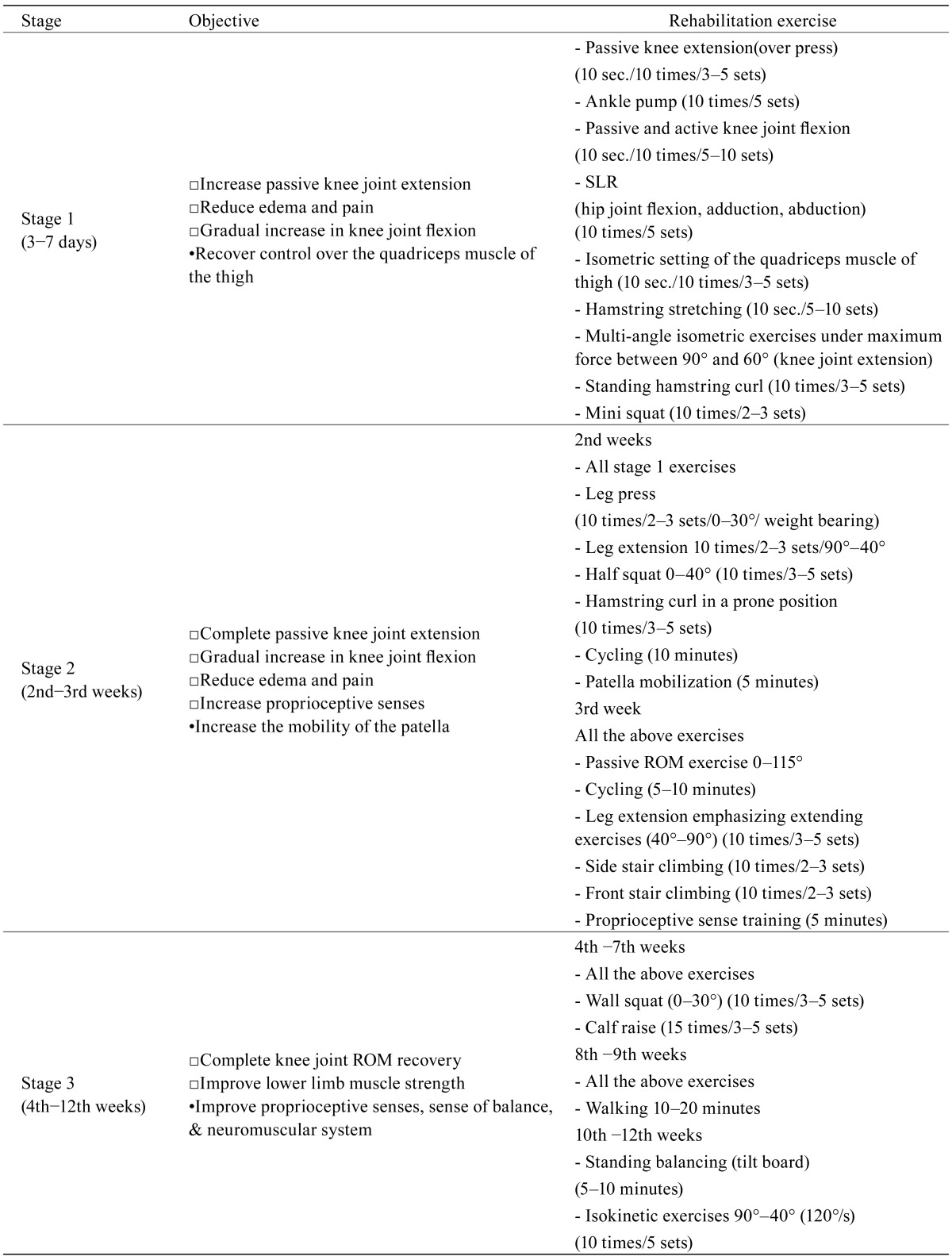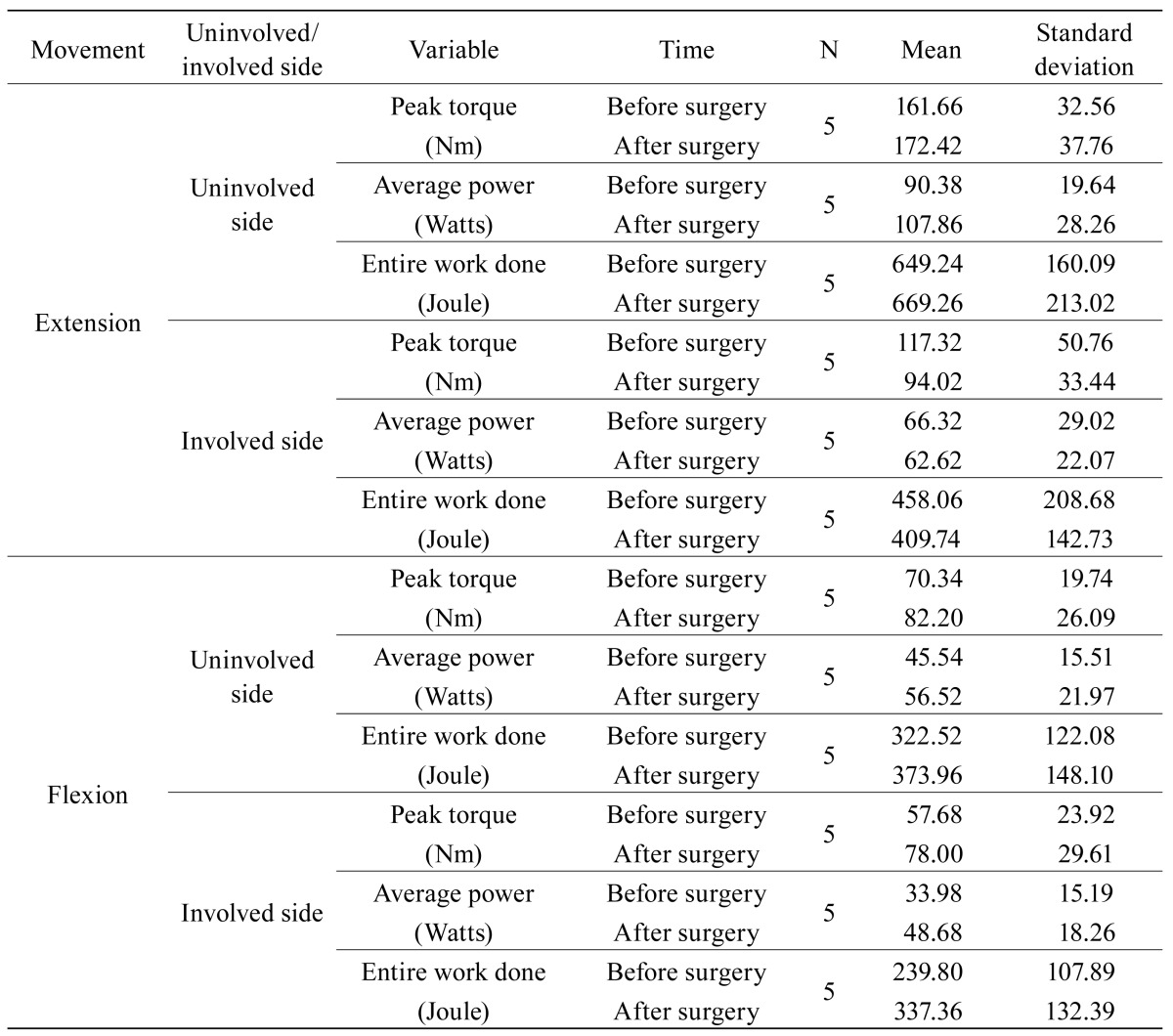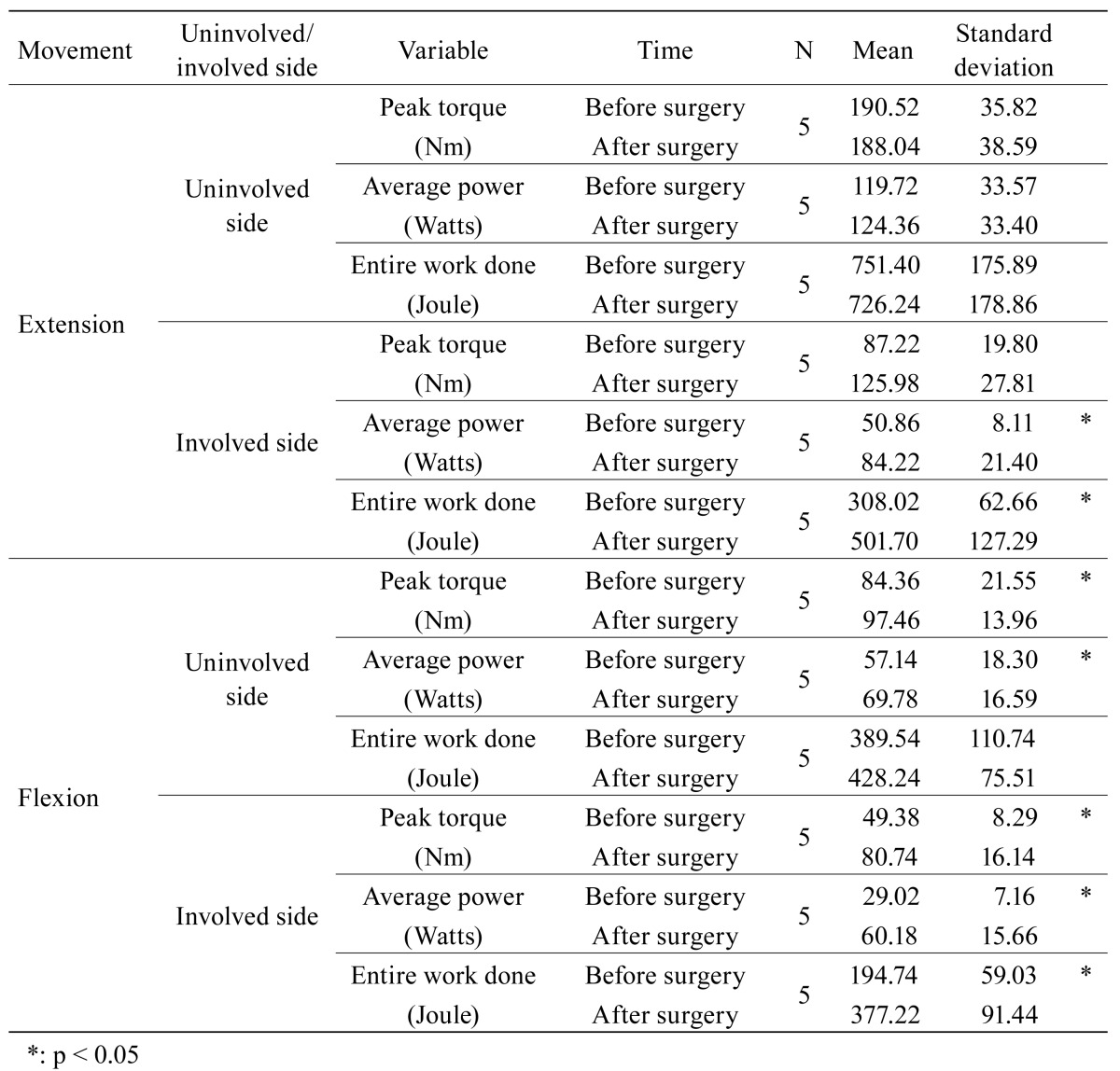Abstract
[Purpose] To examine changes in the knee joint’s isokinetic muscle functions following systematic and gradual rehabilitation exercises lasting for 12 weeks for male and female patients who underwent anterior cruciate ligament (ACL) reconstruction. Differences in muscle functions between the uninvolved side (US) and the involved side (IS) before surgery, differences in muscle functions between US and IS after rehabilitation exercises lasting for 12 weeks, and changes in muscle functions on US and IS between before and after surgery were analyzed to examine the effects of accelerated rehabilitation exercises after ACL reconstruction. [Subjects] The study subjects were 10 patients, five females and five males, who underwent ACL reconstruction performed by the same surgeon. [Methods] As a measuring tool, a Biodex Multi-joint system 3pro (USA), which is an isokinetic measuring device, was used to examine the flexion and extension forces of the knee joint. During isokinetic muscle strength evaluation, the ROM of US was set to be the same as that of IS for consistency of measurement. [Results] At 60°/s, the isokinetic muscle functions of the females did not show any significant change between before and after surgery in any of the variables on both US and IS. At 60°/s, the isokinetic muscle functions of the males did not show any significant change between before and after surgery in the peak torque, average power, and entire work done on US. In extension, peak torque on IS did not show any significant change.
Key words: Anterior cruciate ligament, Isokinetic, Rehabilitation
INTRODUCTION
Although anterior cruciate ligament (ACL) damage occurs most frequently in populations aged 15–25 years participating in pivoting sports, it can occur in people of any age1). At least 80,000–250,000 cases of ACL damage occur annually in the USA, and ACL ruptures occur annually at a ratio of approximately one per every 3,000 people2). Since ACL damage frequently occurs, incurs large treatment expenses, and can cause various complications even after surgical treatment, many studies have been conducted on ACL damage-related surgery and rehabilitation exercises. Although recent methods of rehabilitation after ACL reconstruction are faster and more diverse, the purpose of rehabilitation exercises is invariably to reduce knee joint instability to enable activities without damage. An important objective of rehabilitation exercise after ACL reconstruction is the recovery of the normal muscle strength of the femoral muscles3). Since the recovery of the original muscle strength after atrophy of the femoral muscles takes a long time, disuse atrophy of the femoral muscles is considered very important in knee joint surgery. Although experts in exercise prescriptions have recently been examining the effects of accelerated rehabilitation exercises after ACL reconstruction, no study has been conducted on differences in the effects of accelerated rehabilitation exercises between males and females. Therefore, research is needed into muscle functions with changes in muscle strength and muscle power, which are the core of rehabilitation exercises, after the performance of accelerated rehabilitation exercises after ACL reconstruction. The purpose of the present study was to examine changes in the knee joint’s isokinetic muscle functions after systematic and gradual rehabilitation exercises lasting for 12 weeks for male and female patients who underwent ACL reconstruction. Differences in muscle functions between the uninvolved side (US) and the involved side (IS) before surgery, differences in muscle functions between US and IS after rehabilitation exercises for 12 weeks, and changes in muscle functions on US and IS between before and after surgery were analyzed to examine the effects of accelerated rehabilitation exercises after ACL reconstruction.
SUBJECTS AND METHODS
The study subjects were 10 patients, five females and five males, who underwent ACL reconstruction performed by the same surgeon. The male group was (mean±SD) 25.80±1.92 years old, 173.00±5.83 cm tall, and 67.00±7.28 kg in weight. The female group was 26.60±3.44 years old, 167.40±4.77 cm tall, and 63.20±7.73 kg in weight.
To ensure the safety and validity of rehabilitation exercises, a rehabilitation exercise program was prepared as follows. Based on a review of the literature related to rehabilitation exercises after ACL reconstruction, Wilk’s accelerated rehabilitation exercise program after ACL reconstruction was modified for the content of the rehabilitation exercise program (Table 1).
Table 1. Objectives of rehabilitation exercise programs after ACL reconstruction by stage and rehabilitation exercises.

As a measuring tool, a Biodex Multi-joint system 3pro (USA), which is an isokinetic measuring device, was used to examine the flexion and extension forces of the knee joint. The measuring method was as follows. For accurate measurement during tests, test motions were practiced three times with maximum muscle strength before measurements were taken, and the measurements were conducted after a rest had been taken. To prevent the force of the other parts of the body from acting during repeated knee joint extension and flexion exercises, the subject was instructed to sit on the chair, and the subject’s shoulder, chest, and pelvis were fixed using a belt connected to the chair. Then, the thigh of the subject was fixed using the thigh stabilization belt. The length of the belt of the dynamometer was adjusted so that the shin pad was placed approximately 1 cm above the lateral malleolus of the ankle joint, the force point, and the shin pad was fixed using a Velcro strap. The axis of the dynamometer was aligned with the axis of exercise, and the subjects were verbally encouraged to exert maximum muscle strength during the test. The same ROM was use for the isokinetic muscle strength tests. The entire work done is a variable that can provide information useful for determining the degree of injury rehabilitation, because this value is affected by the ROM. Therefore, in the present study, during isokinetic muscle strength evaluation, the ROM of US was the same as that of IS for consistency of measurement. The study data were statistically processed using the SPSS 15.0 statistics program for Windows. Preoperative differences in isokinetic muscle functions between US and IS, postoperative differences in isokinetic muscle functions between US and IS, and differences in isokinetic muscle functions between before and after surgery on each of US and IS were analyzed using the paired t-test with a significance level of α=0.05.
All the subjects understood the purpose of this study and provided their written informed consent prior to their participation in the study in accordance with the ethical standards of the Declaration of Helsinki.
RESULTS
At 60°/s, the isokinetic muscle functions of the females did not show any significant change between before and after surgery in any of variables on both US and IS (Table 2). At 60°/s, the isokinetic muscle functions of the males did not show any significant change between before and after surgery in peak torque, average power, and entire work done on US (Table 3). In extension, the peak torque on IS did not show any significant change. However, in extension, the average power and entire work done on IS significantly increased (p<0.05). In flexion, whereas the peak torque and average power on US significantly increased (p<0.05), the entire work done on the same side did not show any significant change. In flexion, the peak torque, average power, and entire work done on IS significantly increased (p<0.01).
Table 2. Changes in females’ isokinetic muscle functions between before and after surgery at an angular velocity of 60°/s.

Table 3. Changes in males’ isokinetic muscle functions between before and after surgery at an angular velocity of 60°/s.

DISCUSSION
Rehabilitation exercises after ACL reconstruction are receiving attention from many experts in sports medicine. Traditional rehabilitation exercise methods restrict the range of motion, do not apply weight bearing at the beginning, and are composed of only low intensity exercises. Therefore, 9–12 months of rehabilitation is required before returning to sport activities. However, accelerated rehabilitation programs are composed of immediate and active rehabilitation exercises after surgery, and have been reported to enable a return to sport activities in approximately six months after ACL reconstruction4). Studies related to the evaluation of ACL reconstruction patients’ muscle strength report that an analysis of the deficit ratio of IS to US is more valuable than the evaluation of individual muscle strengths5, 6). Clinical specialists, referring to empirical evidence, point out that applying the same accelerated rehabilitation exercises is somewhat impractical. Therefore, in the present study, the discussion focuses on the results of the application of a modified Wilk’s accelerated rehabilitation exercise program lasting for 12 weeks after ACL reconstruction surgery7).
At 60°/s, the isokinetic muscle functions of the females did not show any significant change between before and after surgery in any variable on both US and IS. At 60°/s, the isokinetic muscle functions of the males did not show any significant change between before and after surgery, except that in extension, the average power and entire work done on IS significantly increased (p<0.05). Therefore, we consider 12-week duration rehabilitation exercises are incapable of improving knee joint extension muscle functions in females, but are capable of partially recovering extensor muscle functions on IS in males. Evidence in support of this conclusion includes a study on gender differences regarding the effects of rehabilitation exercises after ACL reconstruction conducted by An8), who found that when the same rehabilitation exercises were performed by both males and females, subjective knee evaluation scores (2000 International knee document committee subjective knee evaluation: 2000 IKDC) of males had improved at 12 weeks after surgery, whereas IKDC scores of females had decreased. This result is consistent with the present study results that show different responses of males and females after 12 weeks of rehabilitation exercises after ACL reconstruction.
Male and female patients exhibited different effects after a 12-week course of rehabilitation exercises for the recovery of knee joint muscle functions after ACL reconstruction. For full recovery of knee joint muscle functions after surgery, rehabilitation exercises of longer duration are necessary.
REFERENCES
- 1.Griffin LY, Agel J, Albohm MJ, et al. : Non-contact anterior cruciate ligament injuries: risk factors and prevention strategies. J Am Acad Orthop Surg, 2000, 8: 141–150 [DOI] [PubMed] [Google Scholar]
- 2.Huston LJ, Greenfield ML, Wojtys EM: Anterior cruciate ligament injuries in the female athlete. Potential risk factors. Clin Orthop Relat Res, 2000, 372: 50–63 [DOI] [PubMed] [Google Scholar]
- 3.Augustsson J, Thomee’ R, Linden C, et al. : Single-leg hop testing following fatigue ins exercise: reliability and biomechanical analysis. Scand J Med Sci Sports, 2006, 16: 111–120 [DOI] [PubMed] [Google Scholar]
- 4.Shelbourne KD, Nitz P: Accelerated rehabilitation after anterior cruciate ligament reconstruction. Am J Sports Med, 1990, 18: 292–299 [DOI] [PubMed] [Google Scholar]
- 5.Moisala AS, Jawrvelae T, Kannus P, et al. : Muscle strength evaluations after ACL reconstruction. Int J Sports Med, 2007, 28: 868–872 [DOI] [PubMed] [Google Scholar]
- 6.Risberg MA, Holm I, Myklebust G, et al. : Neuromuscular training versus strength training during first 6 months after anterior cruciate ligament reconstruction: a randomized clinical trial. Phys Ther, 2007, 87: 737–750 [DOI] [PubMed] [Google Scholar]
- 7.D’Amato M, Bach BR, Jr: Knee injuries. In Brotzman S B & Wilk K E: Clinical orthopaedic rehabilitation, 2nd ed. Philadelphia: Mosby, 2003, pp286–290. [Google Scholar]
- 8.An KO: Gender Differences in the Effect of a Rehabilitative Exercise Training Program After Anterior Cruciate Ligament Reconstruction. Dissertation of Graduate School, Dankook University, 2009, 11–15.


